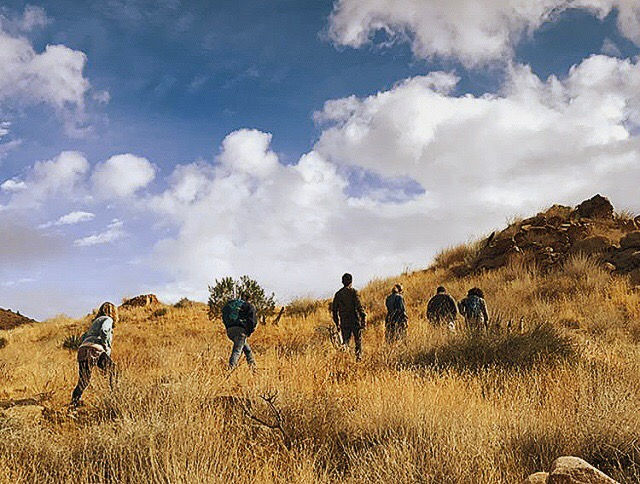Lobaria pulmonaria - Lung Lichen, a lichen story.
- Christina Every Leaf Speaks Botanical Studies
- Dec 3, 2020
- 3 min read

Lobaria pulmonaria, Lungwort, Lung Lichen, Oak Lungwort are just a few of the common names for this epiphyte, foliose (leaf-like) lichen native to North America, Africa, Asia and Europe. This was one of the many lichens I met while in the PNW for school. Though our field studies did not include lichens, I was drawn to it's lung-like appearance especially after learning that they are nitrogen-fixing and pollution sensitive individuals. These slow growing, long lived lichens are found dressing old growth conifers, hardwoods, mossy rocks and rotting wood in the humid old growth forest. All lichens are composed of a fungus and algae and the algae in Lung Lichen is what gives it the green tone which is capable of photosynthesis. In the drier months of the year the tone is more of a dull grey which can change to a brighter blue-green when it is damp. Typically the summer months when rain is absent for a period of time is when you will find it in its dull grey state, whereas in the autumn, winter and spring they are vibrantly gleaming of their blue-green tone. Lung Lichen is an important component of the old growth forests, one reason being that when they fall from the trees to the forest floor and decompose the lichen will fix the nitrogen in the soil. They also serve as a a source of food for wildlife. I learned that they are a sign of a healthy forest, unfortunately they have been impacted by habitat loss and fire and in some countries in Europe they are threatened and protected.
The common and scientific name lends to it's appearance which resembles that of lung tissue which perfectly fits the model of Doctrine of Signatures (I personally do not subscribe to that modality when in comes to herbalism). L. pulmonaria has traditionally been used to treat upper and lower respiratory ailments i.e. asthma, bronchitis, pneumonia, laryngitis. Lichens like Lung Lichen, Usnea and other lichens contain secondary metabolites known as usnic acid, a powerful antibacterial that has been used in the treatment of staphylococcus, bacterial infections, tuberculosis and strep. In fact many lichens are being researched for medicinal purposes, but before folks start jumping the foraging wagon for lichens please do not assume that all lichens can be used interchangeably and consider the ecological importance of these slow growing and long lived beings.
On the thermal spectrum Lung Lichen is cooling having demulcent, emollient, astringent and expectoranting actions, in many ways it reminds me of Mullein,Verbascum thapsus in the sense that it too has an affinity to the respiratory system and is also a cooling, demulcent, astringent with expectorating actions. I prefer to work with Mullein as it is readily available in the herbal marketplace and it is a non native invasive plant that many folks would be happy to have someone harvest roots and aerial parts from their garden. If Mullein peeks your intrest here are some sources. Oshala Farm, is our friends organic farm in Southern Oregon who are sustainability cultivating medicinal herbs as well as offering an array of herbal blend teas, skincare and more. Another source is Mountain Rose Herbs.
Lung Lichen has also been used for urinary tract infections, being that it is a cooling demulcent it would be ideal as part of a comprehensive program for soothing UTIs where there is heat and burning present as well as it possesses antibacterial properties.

Dry lungs, smokers cough, dry irritated coughs especially those exasperated by smoke (fires), sore throats, folks who use their voice often i.e teachers, musicians etc can benefit from drinking a tea made with Lung Lichen using the decoction method and or a tincture prepared with the lichen. I tend to stay away from mucilage rich herbs for cases when there is dampness present, however being that it contains tannins which makes it astringent and the fact that it is also expectoranting I would not hesitate it's use for boggy tissue states. Dr. Christopher Hobbs herbalist, botanist, mycologists writes about its traditional use as a cough remedy by boiling the lichen in milk and making what is know as a "lichen chocolate".
Then again there is the naturalized invasive Mullein, a plant that is abundant, a plant that is not impacted by disturbance but in fact it thrives in areas of disturbance. There is conservation work that has teams of volunteers who remove this plant and refer to it as a "weed". Well this "weed" is a medicinal plant that can be used in place of Lung Lichen, in fact you will not find Lung Lichen readily available in the herbal marketplace. I did pick up a little lichen from the forest floor out of curiosity and I can say that though I love this earthy dirt tasting lichen, I prefer to work with Mullein.
Lobaria pulmonaria















Comments